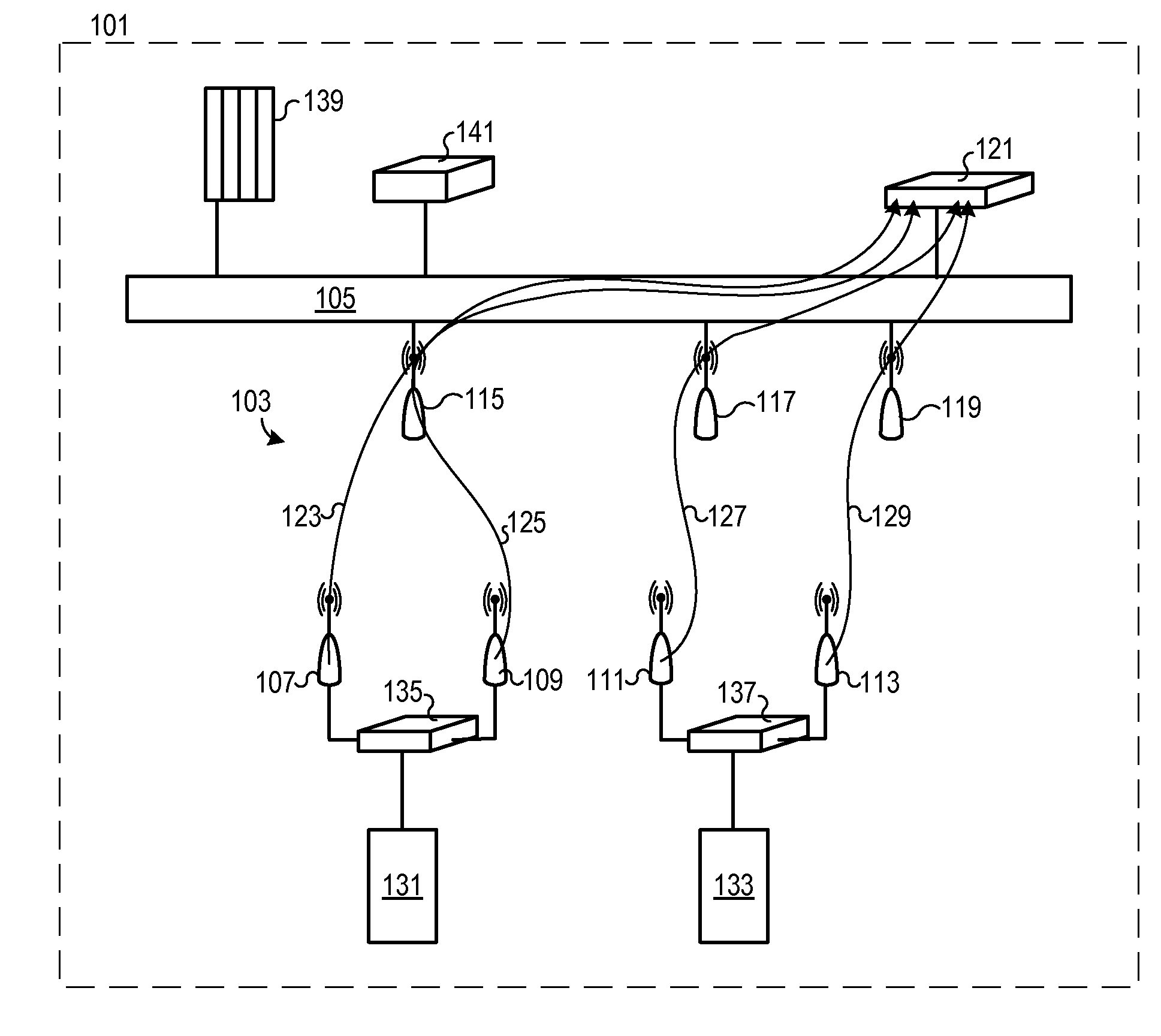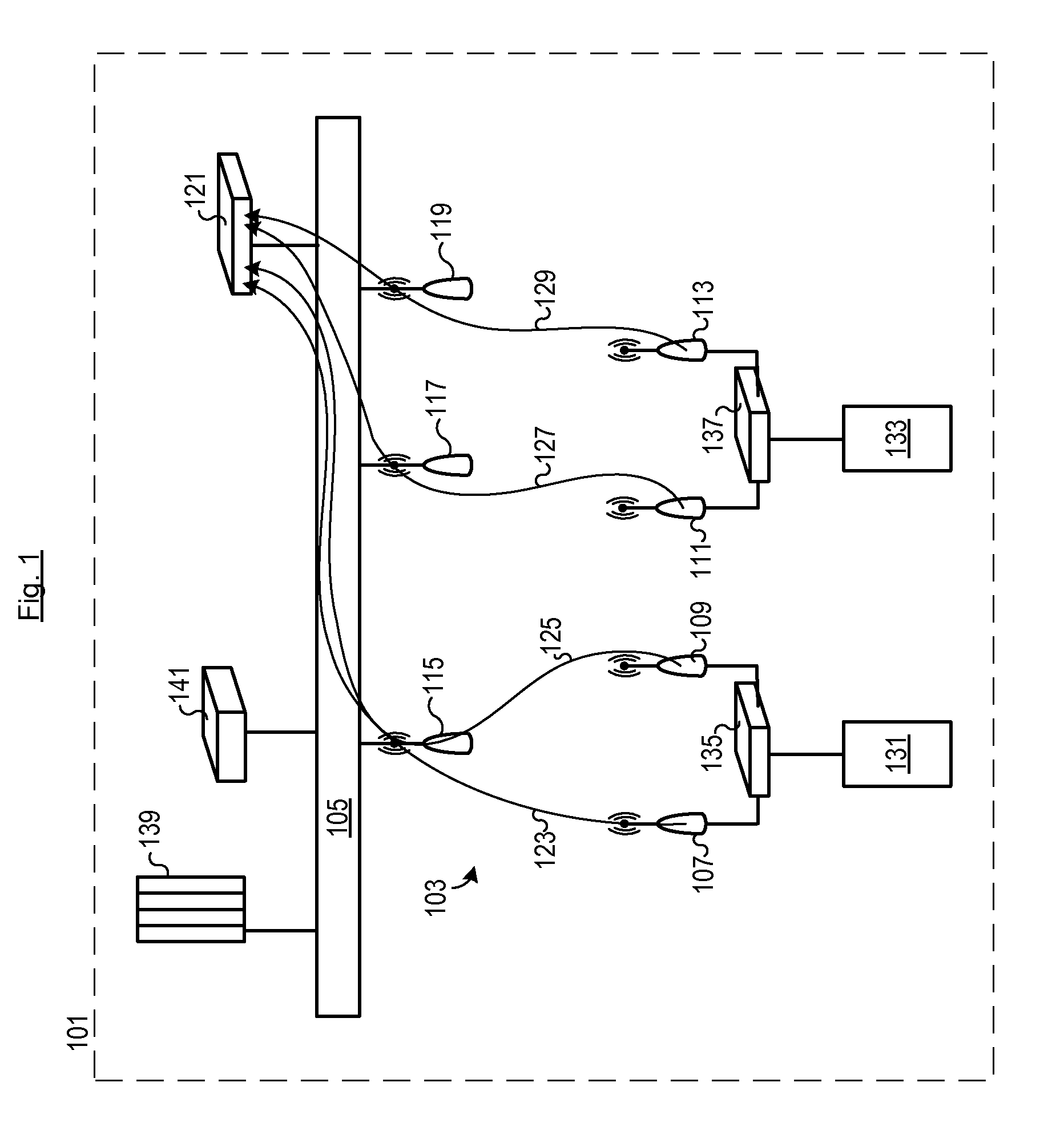[0021]Another
advantage of the invention is seen in customary WLAN infrastructures, in which a
load distribution of clients on multiple access points is provided only via the configuration of the access points. The access points then decide whether other clients are permitted to log on to the
wireless network, or how so-called
Quality of Service (QoS) parameters are allocated for the WLAN communication. However, in this regard the access points have only limited knowledge concerning the actual application, i.e., which specific devices, for example cameras, input / output stations, or drive devices, are controlled. In this case the invention allows client-based
load distribution (load balancing) by the fact that the clients centrally transmit status information to the client control device, which in this respect is more efficient because the clients are the actual load originators. In addition, the central coordination and control of the clients via the client control device allows significantly more application-based coordination of all users of the
wireless network, in particular WLAN users, which in industrial applications such as materials handling technology, for example, is able to accept a much larger number of uniform device types.
[0022]The invention also allows interruption-free
roaming, since the client control device is able to control the client in such a way that
handover times of a client as the result of a new search for more accessible access points as well as
authentication and association with an access point are avoided. Based on the knowledge of the client control device about the
wireless network infrastructure, the client control device is able to send appropriate control signals to the client. The client control device in particular requires knowledge about the wireless network infrastructure based on the status information transmitted by the client and / or based on data transmitted to the client control device using a control device for wireless networks, for example a WLAN controller.
[0023]In one advantageous embodiment, it may be provided that the client control device transmits
Ethernet telegrams and / or
Ethernet packets between the client and the
backbone network via the tunnel. In particular, the client control device bridges Ethernet telegrams and / or Ethernet packets from the clients and / or from the Ethernet users connected to the clients into the backbone
network on ISO layer 2. The client control device preferably delivers telegrams, in particular Ethernet telegrams, from the backbone network via the tunnel to the clients and / or to the Ethernet users connected to the clients. The individual tunnel end points correspond to logically viewed bridge ports of a switch. Logically viewed, the client control device represents a switch having the tunnel end points as switch ports; in contrast to a customary switch, the client control device is able to resolve so-called loops, i.e., the particular clients that are linked to one another for
roaming or redundancy reasons, for example, in particular on the Ethernet level, i.e., on the layer 2 level, and to efficiently use the information thus obtained for controlling the clients.
[0024]In another preferred embodiment of the invention, it may be provided that the data to be transmitted between the client control device and the client are transmitted cyclically. A
cycle time may preferably be set using the client control device. However, it may also be provided that the
cycle time is specified manually.
[0025]In another preferred embodiment of the invention, the client control device automatically optimizes the
cycle time, in particular by taking into account the instantaneously available bandwidth of the wireless connection to the client. In another example of the embodiment of the invention, it may be provided that the cycle time is fixed via an
automation application, for example the
Profinet, wherein the client control device in particular adjusts a transmitting power or a
roaming threshold in the client for ensuring the cycle time during operation.
[0026]According to another preferred embodiment of the invention, the data to be transmitted may be packed into a data frame. Such packing of data into a data frame is also referred to as
packet aggregation. The data frame into which the data to be transmitted are packed may also be referred to as a tunnel frame. In particular, multiple Ethernet packets are packed into a data frame. Thus, multiple data items, in particular Ethernet packets, may be jointly transferred. By means of the
packet aggregation according to the invention, low “
jitter” is achieved in the communication between the client control device and the client and / or an Ethernet user or
end user connected to the client, in particular when the data to be transmitted are transmitted cyclically between the client control device and the client, i.e., when the tunnel between the client control device and the client operates cyclically.
 Login to View More
Login to View More  Login to View More
Login to View More 

